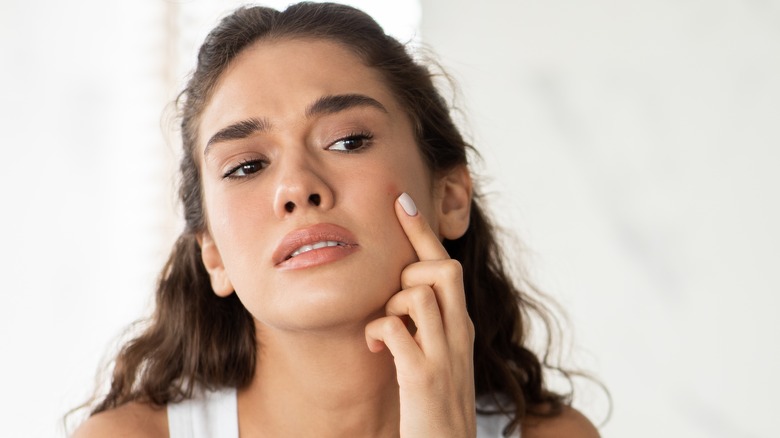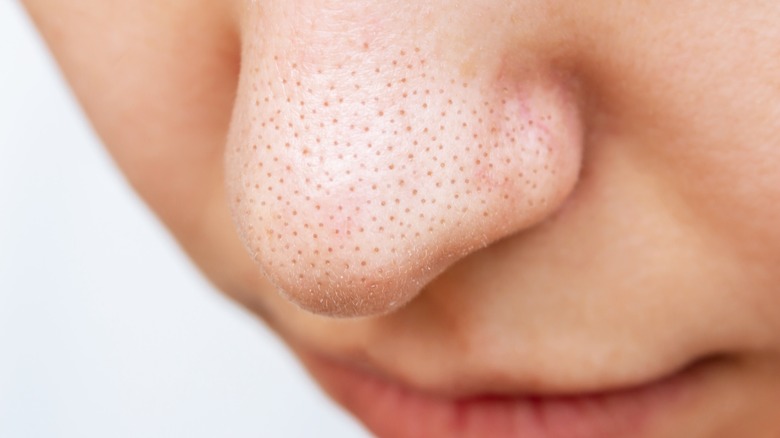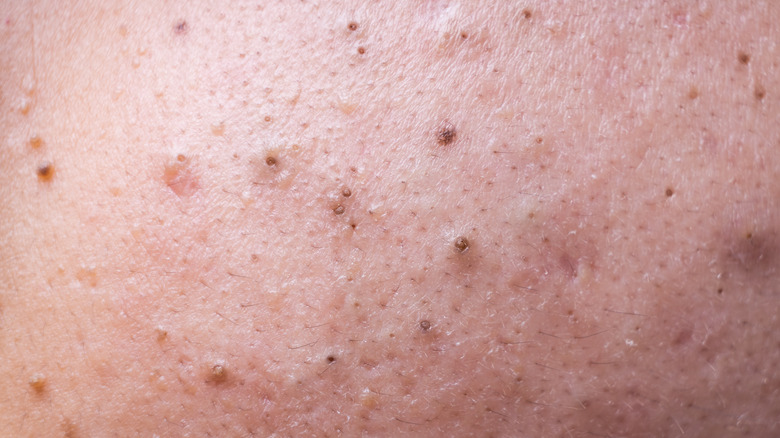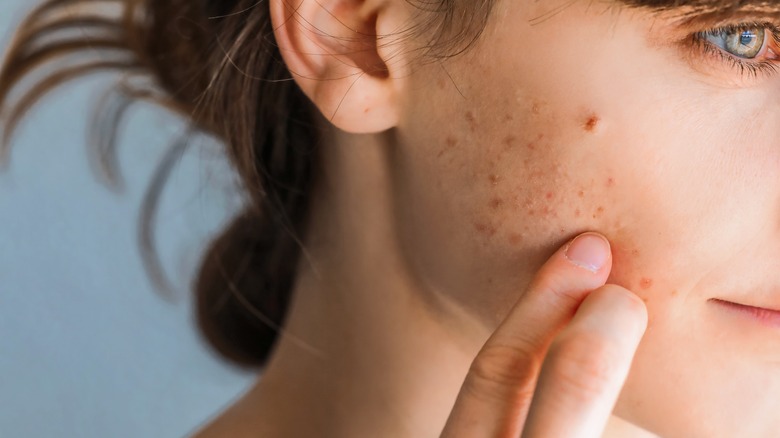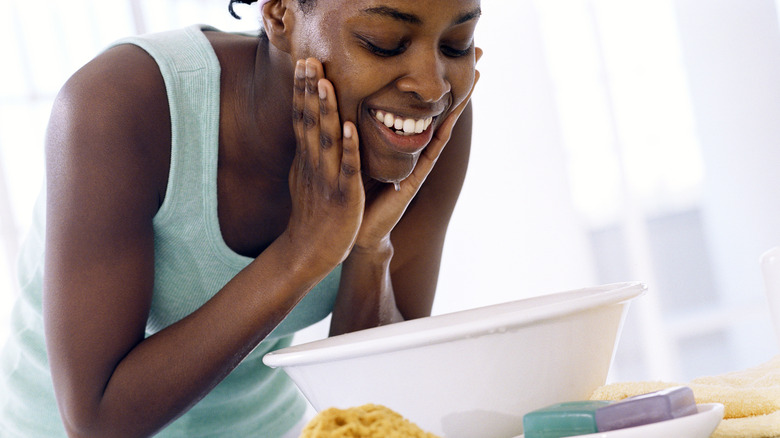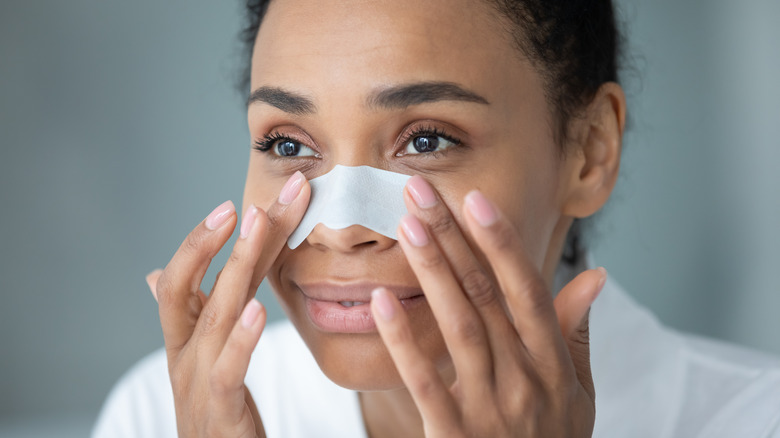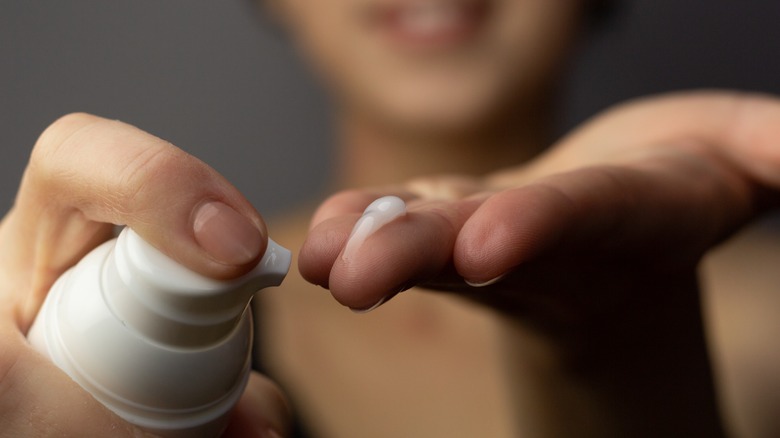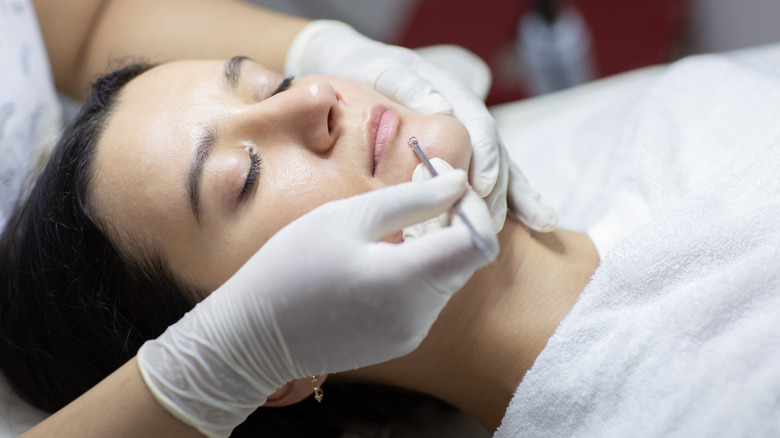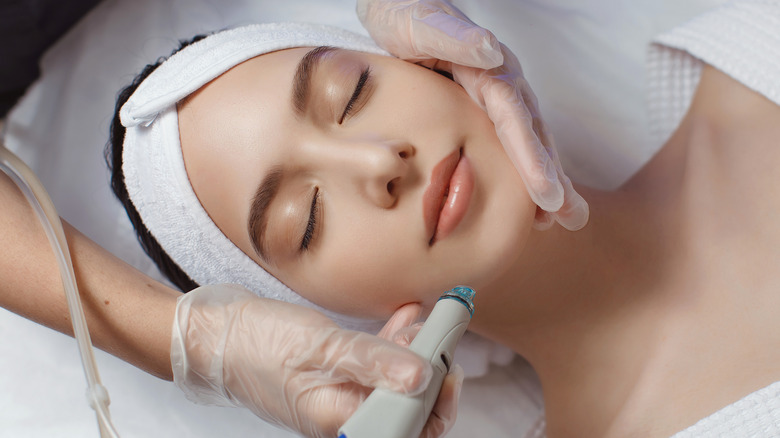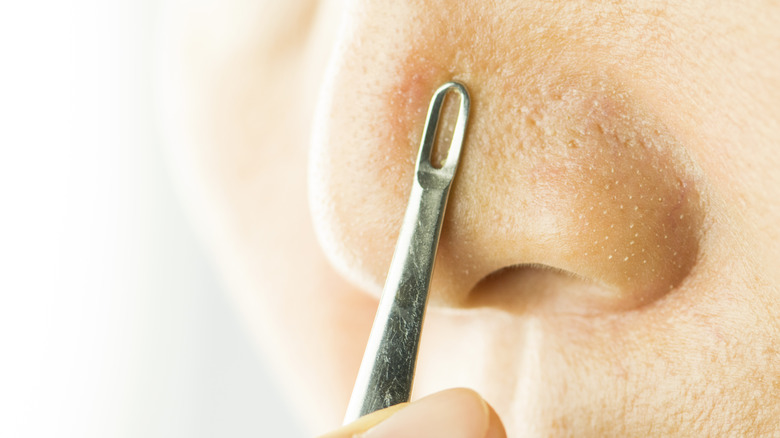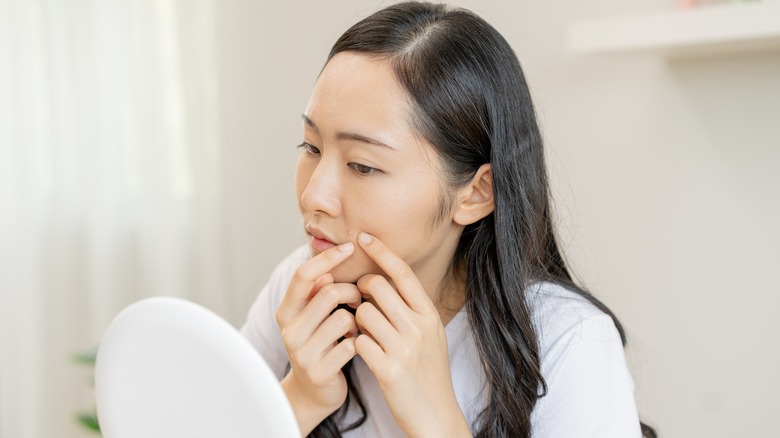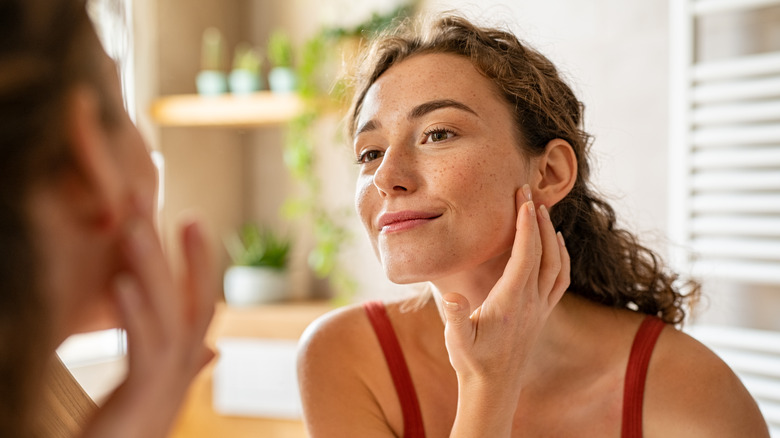All Of Your Blackhead Questions Answered
Getting rid of blackheads can feel like a fruitless, impossible chore. You likely have poured over expert advice and magazine articles since you were a teenager in the hopes of uncovering the secret cure, not to mention experimented with some questionable means of at-home removal. "Almost anyone whose skin has produced oil at any time of their life will likely have blackheads, and almost everyone wishes they didn't," celebrity aesthetician Renée Roleau tells NewBeauty. But no matter what peculiar methods you try, the blackheads don't disappear.
This tricky, stubborn form of acne may be less painful than a pimple and more discreet than a whitehead, but the presence of blackheads causes people endless frustration (via West County Dermatology). It is a major skincare concern for many, but exactly what they are and how to treat them is a mystery. Because of this, it is best to start with the basics. Understanding what a blackhead is and why it forms can be a major benefit to your treatment plan. Additionally, knowing the most effective options and the methods you should avoid can help prevent irreversible skin damage down the line. Here are all of your blackhead questions answered.
What are blackheads?
Blackheads are a common but mild form of acne that appear as tiny dark spots on the skin. "Blackheads, by medical terminology, are called open comedones," dermatologist Reena Rupani, MD tells Mount Sinai. "A comedone is the pore, the opening in your skin, that connects your sebaceous or oil-producing gland, your hair follicle, and little tiny muscles that help your pores open and close. When that pore gets stuffed with debris, dead skin, oil pollution from the environment, that becomes a blackhead." They can show up anywhere on the body, but they most commonly appear on the face in the T-zone, along the forehead, nose, the cheeks, and chin.
Blackheads are often confused for whiteheads or pimples. According to the American Academy of Dermatology Association, the difference comes down to whether or not the clogged pore is open. A bump that is white or flesh-colored exists in a closed pore, while blackheads are exposed to the air. Blackheads also differ from pustules, or pus-filled pimples, which occur when the debris clogging the skin's pores are infected. Both whiteheads and pustules may feel tender or cause discomfort, whereas blackheads are normally painless. Although blackheads do not affect your health or wellbeing, their presence alongside more severe forms of acne can cause significant psychological stress.
What causes blackheads?
Contrary to popular belief, blackheads are not the result of trapped dirt. Blackheads occur when a hair follicle, or pore, becomes clogged and inflamed. According to the Cleveland Clinic, a surplus of keratin, an increased presence of bacteria on the skin, and hormonal changes are all responsible for the formation of blackheads.
Increased sebum, which can come about as a result of an overproduction of testosterone, is also a major factor in blackhead formation (via Proactiv). An excess of oil can occur for a number of reasons. In addition to hormonal imbalances commonly experienced by teenagers and young adults, dehydration, sweating, genetics, smoking, lack of sleep, and exercise can all play a role.
When excess sebum, bacteria, and dead skin cells clog the hair follicle, the surface remains open. In the dead skin cells is a substance called melanin which is responsible for producing hair, eye, and skin pigment. According to the ACS, when the melanin meets oxygen in the air we breathe, it results in the dark coloring of blackheads.
Blackheads affect people of all ages
Acne, including blackheads, are a common skin condition for people between the ages of 12 and 25. According to Drugwatch, the hormonal changes that occur during puberty are largely responsible for the presence of the pesky, black spots and can last for several years. People who experience other forms of acne are more susceptible to blackheads as well (via Everyday Health). As the body ages into adulthood and the hormone production regulates, blackheads may decrease or disappear altogether.
However, it is a myth that blackheads only affect teenagers going through puberty. "It's a common misconception to think of acne as a teenage disease," says Yale Medicine dermatologist Christopher Bunick, MD, PhD. One of the most common reasons adult women between the ages of 20 to 40, for example, come to the dermatology clinic is for acne. Clinical trial data revealed that approximately 50% of women in their 20s, 33% of women in their 30s, and 25% of women in their 40s suffer from acne." Experts aren't exactly sure why blackheads persist into adulthood for some, however a family history of acne may explain why some people are more prone to developing them later in life.
Can blackheads be prevented?
Blackheads are notoriously difficult to get rid of once they appear on your skin. But can they be prevented? According to Kiehl's, there is no way to definitively cure any type of skin concern, including acne and blackheads. However, there are some basic skincare steps you can incorporate into your daily routine to help prevent blackheads from getting worse.
The American Academy of Dermatology Association recommends washing your face twice a day with a mild, non-comedogenic cleanser and gently rinsing off with warm water. It is important to ensure that your face is well hydrated to prevent dry, irritated skin. Using an oil-free, scent-free moisturizer after washing your face will help keep your skin soft and hydrated, which can also help control the overproduction of oil. Abrasive facial scrubs may be tempting to use to remove the build-up of gunk and dead skin cells in your pores, but these physical exfoliants are likely to do more harm than good. According to Everyday Health, these scrubs end up interfering in the skin's innate moisture and can end up making it oily. They don't penetrate deep enough into the pore, where the actual blackhead develops, to successfully get rid of the blockage.
Being mindful of the types of products you put on your face to help prevent blackheads is also important. Non-comedogenic makeup is vital, especially if it is worn on a daily basis. Make sure to regularly clean your makeup brushes, applicators, and hair tools as well.
Do pore strips work?
Pore strips, commonly referred to as nose strips, are a decades-old, disgustingly satisfying tool for removing blackheads. The sticky paper strips are designed to remove the top layers of dead skin and blackheads using a strong layer of adhesive. They are also easy to use. Simply wash your face and apply a fresh strip to the wet skin of your nose. Leave on for 10 to 20 minutes and then gently pull off. If you've ever used a pore strip, you know how gross the back looks once it's been removed. But are they actually effective at treating or removing blackheads from the nose area?
"Pore strips can help (very) temporarily to improve the appearance of pores, but there is no permanent change or improvements to the skin achieved with such a strip," dermatologist Shari Marchbein tells Allure. Experts agree that pore strips are helpful for removing a large portion of the surface level gunk present in your pores. If used correctly no more than twice a week, you may notice your pores look smaller and cleaner.
However, pore strips aren't a permanent solution for blackheads as they don't help treat the root cause of their existence. They also aren't for everybody. People with sensitive skin, skin conditions like rosacea, adhesive allergies, or those who use topical retinoid medicines to treat other kinds of acne may find pore strips cause significant irritation or pain.
The most effective topical treatments for blackheads
Salicylic acid is a beta-hydroxy acid, or a type of gentle exfoliant that helps support the shedding of dead skin cells (via CeraVe). Unlike pore strips, salicylic acid can effectively penetrate the pores and destroy the acne at its source. "Those wonderful acids are really emulsifying all that buildup that we have in our pores," celebrity aesthetician Crystal Koro tells Popsugar. "Think of it as giving your skin a good workout." Salicylic acid also helps control excess oil production, which makes it a great option for people with oily and acne-prone skin. Regular use depends on skin sensitivity and what other products it is combined with, but it is generally considered safe for daily use.
Retinoids are a popular topical cosmetic treatment derived from vitamin A. They are extremely useful for evening out the skin tone and reducing the appearance of fine lines and wrinkles. They are also a great treatment for blackheads. According to The Washington Post, retinoids can help tackle the root cause of blackheads, by reducing the oiliness of the skin and blocked pores. Retinoids vary in strength, with some only available with a prescription. Generally retinoids can be used daily, although depending on the individual product's strength it may be necessary to slowly work up to daily use. If you opt for a retinoid as a part of your daily skincare routine, make sure to wear sunscreen and moisturizer as retinoids can cause skin irritation.
Professional blackhead treatment and extraction
Although topical, at-home treatments work for most people, severe or extra persistent blackheads may need to be professionally extracted. Having an aesthetician or dermatologist extract blackheads as a part of a facial treatment will ensure they are removed safely. During a facial, an aesthetician will use steam to help soften and remove dirt clogging the pores (via Simply Skin Esthetics). Then, after cleansing, the professional will use gloves and cotton pads before applying gentle pressure or a tool called an extractor to remove the comedone.
Glycolic acid chemical peels are a more expensive but effective professional blackhead treatment an expert can perform. "Glycolic acid has a small molecular structure, giving it the ability to travel deep into the layers of the skin. Once there, the acid dissolves excess sebum and dead skin cells, revealing smoother, brighter, and younger-looking skin," licensed aesthetician Krista Eichten tells Byrdie. Glycolic acid is an exfoliant and helps to keep the pores clear. It also helps diminish the appearance of fine lines and wrinkles, reform texture, and reveals bright, luminous skin.
It is always safer to have blackheads removed by a professional. Skin experts know the appropriate ways to prep the skin and are able to figure out how deep your pores are. They can also determine the safest, most effective treatment and products you can use for prevention purposes.
Can laser therapy remove blackheads?
In recent years, laser therapy has become a more popular treatment option for removing blackheads. According to AAENT, laser therapy reduces oil production, removes dead skin cells, and stunts bacteria growth in the pores. The procedure is done in approximately 20 to 30 minutes.
It is a safe, low risk procedure but may cause mild redness, swelling, or skin burns that fade within 24 hours. It is necessary to stay out of the sun right after a laser or light therapy treatment. Results are also not guaranteed. According to the American Academy of Dermatology Association, multiple sessions are required to see long-term results and it is unlikely that the treatment will remove all of your blackheads. After a few laser treatments, you will notice some improvement but it may not significantly reduce blackheads until several more treatments are completed at a dermatologist's office or a plastic surgery clinic.
How to use an extractor tool
Blackhead extractors are stainless steel tools shaped like tweezers with two loops on either end. They are commonly used at salons and spas, but they are available for at-home use. Generally speaking extractors are safe to use occasionally, but they shouldn't be relied upon as a sole blackhead treatment.
"It works by gently pushing the clogged sebum out of the pore," Morgan Rackley, an Atlanta-based aesthetician, tells Real Simple. "If using a comedone extractor at home, I recommend using only the rounded side — some come with a pointed side to open the blackhead/whitehead, but unless you're a professional, you run the risk of cutting too deeply and causing injury when using this side."
Using a blackhead extractor requires a gentle touch, patience, and plenty of skin prep. In addition to cleaning the extractor tool, it is important to clean your skin and prepare the area with either steam or a warm compress. "Gently press on each side of the blackhead until it begins to release," celebrity aesthetician Renée Rouleau tells Glamour. "Apply slow, even pressure, and once you are able, lightly pinch the tweezers and pull the blacked-out material from the skin to extract it. If the blackhead does not release easily, do not continue to attempt the extraction." When you are finished extracting the blackheads wash your face or use an alcohol-free toner with antibacterial components to help flush out any lingering gunk in the pores.
Why you shouldn't remove blackheads on your own
Extractor tools aside, it is generally recommended that people don't remove blackheads on their own. Everyone knows how satisfying and addictive it is to squeeze out the unsightly black gunk with your fingertips. However, doing so is not only time consuming but it can cause serious, irreversible skin damage.
"Squeezing, picking, pulling, prodding-all of that can stretch the elastic around the pores, which makes them wider and larger, and they won't bounce back into shape," Weill Medical College instructor Dr. Michelle Henry tells Clinique. "Ultimately, your pores will look larger and become increasingly more visible. The perimeter of your pore is like the neck of a t-shirt. Once it is stretched out, it'll never go back to its original shape." In addition to the physical damage done to the pores, manually popping blackheads introduces a host of bacteria, dirt, and oil from your fingers. This can cause more inflammation, scarring, and hyperpigmentation, and can ultimately lead to more blackheads.
If you absolutely cannot resist extracting a blackhead, West County Dermatology recommends using cotton pads or tissue after properly cleansing and prepping the skin. Using the cotton or tissue, gently push on both sides of the blackhead to extract the plug. Alternatively, you can also wear gloves to prevent skin-to-skin contact. Be careful not to press down with your fingernails, as this can lead to irreversible scarring.
What happens if blackheads are left untreated?
Blackheads may be a major buzzkill on important days and a skincare annoyance of the highest order, but they aren't dangerous, painful, or contagious. Technically speaking, they do not have to be removed for health or wellness purposes. Many choose to remove them because they don't like the look of them or the way they make them feel. But what happens if you don't have the funds to get them professionally extracted? What if you don't buy pore strips or other over-the-counter products and you don't remove blackheads?
In some cases, they may remove themselves. "The pores on our face, just like our ear canals, are designed to clean themselves," Dr. Michael Freeman explains to Skincare Hero. "So for most people, leaving them to their own devices is fine, and just cleansing the face is enough." According to Bioré, the human body is designed to remove unwanted substances, including sebum plugs.
Of course, some untreated blackheads may cause you more problems than others. A stubborn, untreated one may obtain a buildup of bacteria and become inflamed. If left alone this type of blackhead may turn into a large, swollen pimple that is painful to the touch. That is why it is important to, at a minimum, wash your face twice a day with a mild cleanser appropriate for your skin type.
